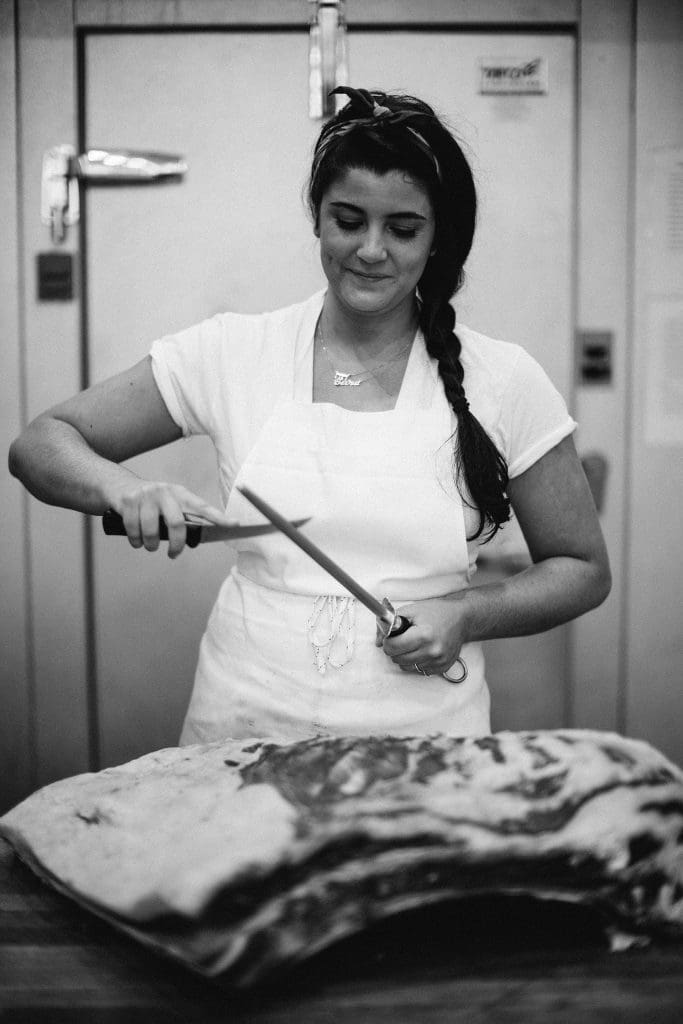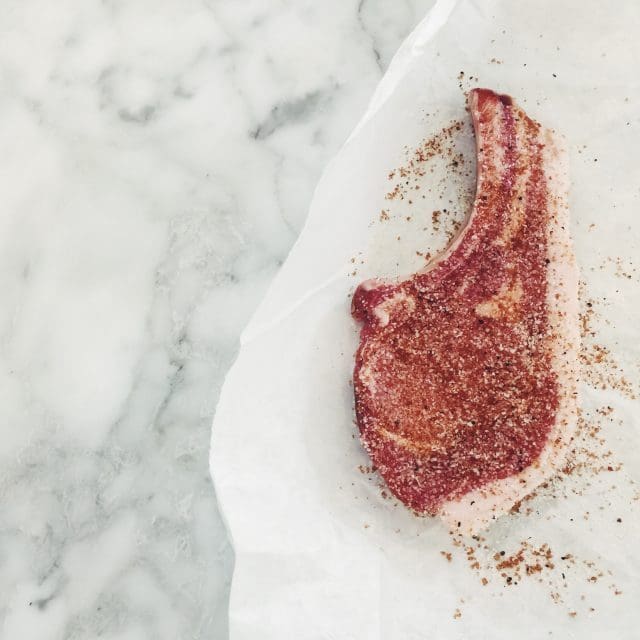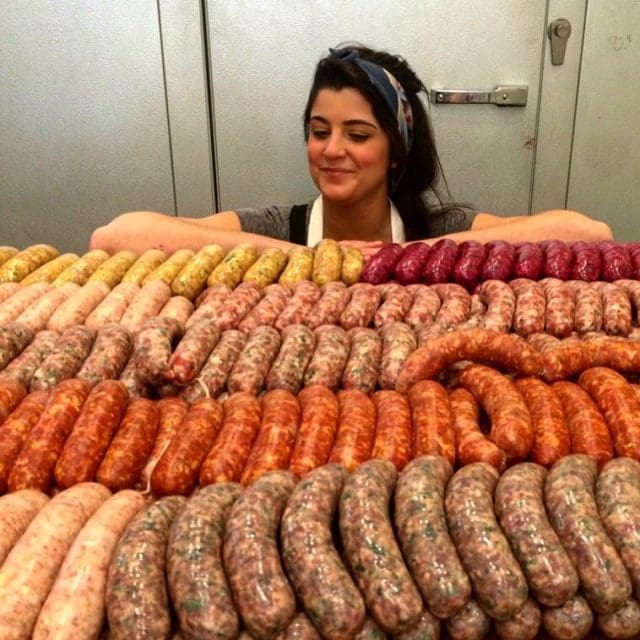
Pro Tips: a new series on Joy the Baker wherein I ask my expert friends loads of questions about their field and get the nitty gritty for all of us. Previously: Ask A Financial Planner and Ask A Sommelier.
Today I’m talking to dear friend, Cara Nicoletti, a fourth generation butcher working in Brooklyn. Yea… the cuts go way way back. Cara started her career as a pastry chef in New York, which means she knows a lot about both cake and cows, an incredible knowledge set, if you ask me (and I’m glad you did). Cara has worked at Meat Hook in Brooklyn, cut in England, written a really lovely book, and now cuts at Foster Sundry. She is bad to the bone… so let’s ask her a few questions about meats. I ask. Cara answers.
Ok, so! I’m sometimes intimidated buying meat. It’s expensive and I feel pressure to cook it right, and before that even happens, I have to store it so it doesn’t go bad before I’m ready to cook it. There’s a lot of pressure. What’s the best way to store meat when you get it home?
You are not alone in this! A huge part of my job is talking customer’s down off a meat-anxiety ledge. It makes sense—meat is expensive, and generally thought of as “the main event.” In my opinion, meat should make you slightly anxious because meat-eating is not a decision to take lightly and it’s always important to remember that.
Okay so now the nitty gritty. If you buy beef from the supermarket, it usually comes packed in something called “modified atmosphere packaging.” During the packing process CO2 gets pumped in to help slow microbial growth. If you break the meat out of this container, you lose this extra level of protection, so it’s best to leave it in there until you’re ready to cook it. Supermarket meat will have a packing and expiration date on it, which gives you a guideline of how long you can keep it before cooking or freezing, but these only apply if your meat has been refrigerated correctly.
If you bought your meat from a butcher A) you rule and B) your meat is probably wrapped in butcher paper. This is usually a breathable wax-lined paper that is freezer-safe. It doesn’t have the extra CO2 protection, so it’s important to keep it wrapped tightly.
You can tell that your meat has gone off first and foremost by smell. Rotten meat has a really bad smell that tells everything in your body and brain to run away from it. That being said, it’s normal for meat that has been shrink-wrapped to have a slightly sulphuric smell when you first open the package. This is just because the package wasn’t breathable. Let the meat air out for 10 minutes and if the smell doesn’t go away, toss it. Another good way to tell if your meat has gone off is by touching it (wash your hands after, obviously). If the surface of the meat is sticky or tacky it’s a no-go. This means that bacteria has started to replicate on the surface of the meat.
If packaged and refrigerated properly, beef, pork, veal and lamb can stay in the refrigerator for between three and five days. Poultry for between 2-3 days. Cooked meat can stay in your fridge 3-4 days before freezing.
Ground meat is more volatile because there is more cross contamination that happens when it is processed through a grinder. There’s also a lot more exposed surface area for bacteria to grow on. Don’t keep it in your fridge for more than 2 days. Freeze it if you’d like to keep it for longer
To extend the shelf life of your whole muscle pieces of meat, you can salt it!

How do you salt something?
Essentially, salting is coating a piece of meat heavily in kosher salt, creating a dry brine that protects and preserves the muscle. It’s best to use kosher salt to salt your meat. Kosher salt was designed by kosher slaughter houses to pull moisture out of meat. The crystals are bigger and it makes it harder for you to over-season it. Old time kitchen hacks we didn’t invent and really should use.
Salt is this magical thing for meat. It makes the muscle strands unwind and then wind back together, creating a net that catches moisture. Salting or brining meat is going to extend its shelf-life, but more importantly it will also make your meat much juicier and evenly-seasoned.
There are two kinds of brines: wet and dry. With a wet brine, you’re making a salt water solution, cooling it, and submerging your meat in it for an extended period of time (generally 24-36 hours). The salt in the wet brine will cause the muscle fibers to unwind and tangle back up again, pulling the water in your brine deep into the muscle fibers and adding moisture back in. Lots of people add garlic and herbs to their brines, but scientifically this doesn’t do much, so really all you’re doing is pumping your meat full of water and diluting its flavor. The moisture is also going to make it harder to get a good sear.
The solution to this is a dry brine! Dry brining is basically a fancy way of saying “salt your meat well in advance.” When you salt your meat at least an hour in advance, the salt sitting on the surface of the meat pulls the moisture from within the meat out and then sucks it back inside. So instead of pumping additional water in, you’re using the meat’s own juices to season the meat. Brilliant!
Are expensive cuts of meat more flavorful and worth the price?
The trade-off is always tenderness versus flavor when it comes to the price of various cuts of meat. Expensive cuts are costly because they’re tender. Cheap cuts are cheap because they take a lot more work to get to tender.
So think about this, the tenderloin—or filet mignon—of a cow is tucked up next to the spine in an area that barely moves. Because it doesn’t work hard it’s going to be super tender, but there will also be less blood-flow to that muscle group, which also means less flavor. You barely need to cook a tender cut like this. On the other hand, something like a beef neck (often just called a “chuck roast”) is working all day long while the animal lifts and lowers its head to eat, so it is going to be a lot tougher and more sinewy, but have a lot more flavor. You want to cook a muscle like this as low and slow as you can, and usually add some liquid like stock or wine so it doesn’t dry out during its long cooking time.
Look for a midrange steak that has both tenderness and flavor.
- Steaks off the shoulder: Flatiron steak is super tender for a shoulder steak, very thin and lean… Quick cooking and shouldn’t cost much.
- A Delmonico steak is the eye of the ribeye as it moves up into the shoulder. It still has all the flavor and marbling of the ribeye but costs less.
- Merlot or Velvet steak: the calf muscle. Should be tough because it’s on the leg but it’s not because its covered in sinew. It’s tender and lean and at medium rare or rare it’s very tender.
- The Denver off the should is an extension of the short rib muscle is fatty and really delicious.
All these steaks you want to give a hard, hot sear in cast iron and then maybe finish it in the oven depending on how thick they are. Really good meat should only need salt and pepper.
Salt and pepper the meat heavily.
Let sit at room temp for an hour.
Heat a cast iron over high heat. Add a neutral oil.
Sear hot 2 to 3 minutes each side. Finish in the oven for a few minute for a thick piece of meat.
Rest for 5 minutes before cutting into.
Note: Many of these are custom cuts and may not be carried in a traditional grocery store. One of the benefits of a whole animal butcher shop is that they have well… the whole animal, and have most every cut (though likely in limited supply).

What should people look for in a butcher shop?
- Look for whole animal shops that carry grass-fed beef. Look to see that the animals are also grass finished or 100% grass-fed. It’s better for you because it’s better for the animal and what’s better for the animal is better for you.
- Look for the animals to be fully pastured not just free range.
- Look for animals from local farms or within 150 miles which often means the butcher shops are working closely with the farmer and the farmer is getting paid more.
- You can ask if the slaughterhouses are humane certified if that’s important to you.
Do butchers know how to cook the meat they sell?
A solid 80% of my job is telling people how to prepare meat. I don’t think you can be a butcher without knowing how to cook the meat you’re selling. They should be able to guide you.
I have a personal problem in that I CAN NOT make a good pork chop. Can you help? Please.
Bone-in pork chops take to brining really well. Two hours before you’re going to cook the pork chop, rub it in kosher salt and sugar and that’s it. Refrigerate on a cooling rack for two hours.
Try reverse searing your pork chop. Start them in the oven at a low temperature like 250. Get it up to an internal temp of 110-115, about 15-20 minutes. Then take it out and sear it super hard to 135 degrees F (and it’ll come up to 140 when resting) about 2-3 minutes on each side.
For no pink, cook it to 145.
What do you wish people would ask you?
I wish they would ask me about vegetable dishes. Seriously though! Eat more vegetables, people!
I wish people would ask me about how they could eat meat more responsibly. I always like when people ask me where meat comes from and how it’s raised. That means that they want to do better. Most of the time my recommendation when it comes to eating meat responsibly is to eat less of it.
Recourses:
EatWild.com to find your local butcher shop
The River Cottage Meat Book. It’s the old school meat bible. It’s great for learning about and ethically raised meat and how to cook it.
Whole Beast Butchery by Ryan Farr who owns a shop in SF. It’s more of a book for learning how to break down an animal but it’s interesting.
Good Meat by Deborah Kasner
Home Production of Quality Meats and Sausages: a self published book by these weirdo Polish dudes who live in the woods… it’s great!






Beverly Minyard
Thank you for including how to do wet and dry brines! My sister is a cook and is always talking about how she dry brines most of her meat and I never knew what she meant. Thank you for the article it was super informative and now I will sound smart when talking about meat!
Shaylee Packer
I didn’t realize that the butcher wraps the meat in butcher paper, because it is a breathable paper, thus allowing the meat to stay better for a longer period. We are having a BBQ at our house in a few weeks, and I am in charge of getting the meat. Maybe I should go to the local butcher, so I can get some advice on what to buy.
Amanda Drew
My husband and I would like to start getting fresh meat rather than the frozen stuff from the grocery stores. Thanks for pointing out that you should pick a butcher who works with local farms that have grass-fed beef. We’ll have to find a butcher service that does all that who we can get meat from.
Letters to Nowhere
I love this series already! Do you have any recommendations for butchers in New Orleans?
joythebaker
Yes, Shank Charcuterie!
Tempie Hughes
Loved this post! So informational! We’re very lucky here in our area to have an awesome butcher shop selling grass-fed beef, pasture raised chicken and pork.
Susan
I love this pro tip series. This was another amazing post. This post contained so much useful information.Thank you so very much, Joy!
sarahstudiesdesign
Cara is a queen and I love this post!
(((Jenée Libby))) (@edaciouspod)
I really enjoyed her book, Voracious! Great read…
Hillary
Love this article. Responsibly raised meat is important to me but sometimes i get lazy. I’ve recently relocated to a new city and this has motivated me to find a local butcher. Thank you!
Gigi Griffis
Possibly dumb question, but once you’re ready to cook the meat, do you rinse off the dry brine solution of salt and sugar? Is there a particular way to do this?
Terry C
This may be one of the best food blog posts I have ever read… thanks!
Des
Joy, you had me at “butcher”–one of my favorite topics. THEN you reveal to me that your friend Cara is the same woman I’ve heard in interviews about cooking her way through literature. I’m overwhelmed right now with the amount of appreciation and respect I have for this post–and the woman whose work inspired it. Thanks so much for sharing!
Suzanne
I really enjoyed this post, especially the discussion on cuts and preparation. Having used a butcher several times when purchasing a specific cut, like prime rib, as well as annually when I split a hog with neighbors and pick up a lamb, I appreciate a butcher that is knowledgeable and encourage anyone who has never tried one to do so. I will say, however, that I was a little disturbed by the grass fed beef suggestions. They do not seem to portray the beef industry, the nutritional facts about beef, or sustainable agriculture and animal husbandry in a full and unbiased way. There is science, as well as ethical discussions, behind these decisions, and when it comes down to it, choosing grass-fed does not mean you are getting beef that is more delicious, more humanely raised, or more nutritious. As a caveat, I am part of a farming family which has raised beef for 135 years, in the State that produces more beef than any other. The University I graduated from has not only a program of study called “Meat Science” but spends a significant funding allotment on research in the industry, particularly as it relates to cattle feed and how that relates to flavor as well as other conditions like the use of antibiotics that impact beef production. I am not an expert, but before making the decision that grass fed is the only beef you will eat – or that producers whom utilize other methods are unethical – I strongly encourage you to read more about the issues that impact the industry, and ultimately the food on your plate. Eating meat is a personal choice: ethical, nutritional, and financial.
I appreciate the perspective presented here, but there are others. For more information on the differences between “grass-fed” and “grain-fed” beef, you can look here, or at many other universities and research institutions:
https://extensionpubs.unl.edu/search/?keyword=beef+report
If you are concerned about the health and treatment of the animals you eat, consider the perspective of a Dartmouth graduate who has raised and finished production beef for twenty years:
https://feedyardfoodie.wordpress.com/category/antibiotics-hormones-and-other-growth-promotants/
And for a more aggressive viewpoint from a cattle producer and butcher:
https://themeatguy.blogspot.com/2013/03/grass-fed-beef-its-probably-not-what.html
There is nothing wrong with eating grass-fed beef, and if you are investigating the source of your meat, as Cara suggested, that is fantastic. You should know where your food comes from and think about what that means to you, and I thank Cara for encouraging people to do that. However, before you demand only grass-fed, think about why you want that, what that label actually means (the USDA defines it), and how important that is to you in comparison to eating a healthy diet, making sure the animals that you do eat are not mistreated, and the health of the meat production industry as a whole and how protein is raised for the billions of people on Earth despite a shrinking amount of arable land.
Karen B.
This is so helpful and I love the series. It’s really great. Thank you.
xo,
Karen
Shauna
I love this series, and loved this post especially. Your friends are awesome!
Anne King
Love this! So much important information for my brain to digest here. Thank you!
Maris
Hi Ms. Joy, your biggest fan here! Really enjoyed this article. I am a little meat-ignorant,so deeply appreciated it. Decided to research meat in my area (San Diego) and found a site in which you or your readers may be interested. https://www.son-riseranch.com/ They are in the Sierra Nevada foothills and have some very unconventional but sound ways of doing things and are a CSA, as well. The articles in the blog are very informative, I mean VERY. A little hard to read at times, because historically we have done some pretty rude cattle raising, but a great read. Thanks for every thing that you do.
Adriana
This was really interesting to me! Thanks for a thoughtful, well rounded conversation about meat!
Lori
I really like your Pro Tips series! Also, just read a preview of Cara’s book and I am going to have to read it! I love the concept. Looks amazing!
Staci C.
Um. This is an amazing post!! So much good information and….who doesn’t have a little anxiety about meat?
Elyse
Nice to see fellow lady butchers rocking the meat world. Great post, great tips.
Jeannette
i just recently decided to try vegetarianism, just to see if it was a fit. i do feel bad that i don’t buy meats that are responsibly raised and butchered, so i thought it best to not eat it all together. it hasn’t worked out 100% for me and i end up eating meat about once a week. reading this, i have decided that i’m going to find a butcher in my city (here’s hoping there’s a good one!) and follow this advise. this post was invaluable for the pork chop tip, alone!! thank you for your knowledge, cara!
Maria
Fabulous post – thanks so much!!!
Sarah
P.S. I used to read the Yummy Books blog and I loved it — It was because of you that I read Goldfinch (which I also loved). I miss your posts. While I have your book, it’s not the same as seeing a fun new recipe and description pop up every so often. . .I realized I never commented on your blog so I thought I should let you know, how great I thought it was.
cara nicoletti
Thank you for your words, Sara! I’m sorry I’ve given yummy books a little break, I think about it/wring my hands about it almost daily. After the book came out I felt like I needed to take a step back and maybe challenge my brain with a new idea. I’ve been working on that, but missing YB a lot lately. I’m hoping to get back to it this winter–possibly in a different format. Thanks for the nudge, I appreciate you! x
cara nicoletti
also sorry my autocorrect did your name dirty.
DisplacedHousewife
I love this! And Cara’s book is amazing — she’s an amazing writer. xo
Sarah
I think an issue with pork chops, especially, is that the kind you find in grocery stores are from pigs that have been bred to be “the other white meat” meaning that a LOT of the fat has been bred out of the animal and the chops dry out during cooking. I had never had a pork chop I liked until we started buying a whole pig from a local farmer. It was a heritage breed and that made all the difference.
Janet
Not the post for me as a vegetarian.
Cait
See, as a vegetarian I actually still enjoyed this post because of Cara’s attitude toward eating meat. I love that she cares about how animals for meat are raised, and that eating meat responsibly does mean eating less of it. I never expected to hear that from a butcher and it’s awesome. I am from the Rust Belt of the US and let me tell you, those people are eating meat come hell or high water, so instead of trying to do the impossible and convert them to being vegetarians, the next best step is to teach about how to buy and eat meat so that the suffering to animals is eliminated as much as possible.
Rock on, Cara!
alyssa
Just had to comment and say I love these pro-tips posts!! I have learned quite a bit from all of them!
Michele
Thank you! Great article. It never occurred to me to ask my butcher about veggies (& I eat lots). I do frequently ask him his opinion on cooking meat though!
francetaste
Excellent info! One of my favorite things, which I don’t eat often because it’s expensive, is steak tartare–raw ground beef. I only buy it from my little village butcher, who cuts it and grinds it before me.